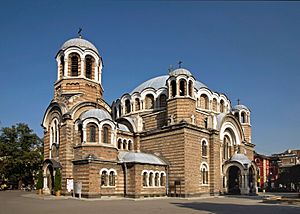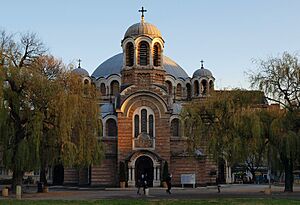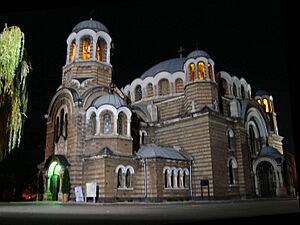Seven Saints Church, Sofia facts for kids
The Sveti Sedmochislenitsi Church is a special Bulgarian Orthodox church in Sofia, the capital city of Bulgaria. Its name means "Holy Seven Saints." This beautiful building was first built in 1547 as a mosque by the Ottoman Empire. Later, it was changed into a Christian church. The church officially opened on July 27, 1903. It is named after two important saints, Cyril and Methodius, and their five students. Together, these seven people are known as the Sedmochislenitsi in the Orthodox Church.
History of the Building
This building, originally called the Black Mosque, was finished around 1547. A powerful leader named Sofu Mehmed Pasha ordered it to be built. He was a governor in the Ottoman Empire. The famous architect Mimar Sinan helped design it.
The mosque was built on a very old spot. Before it, there was a nunnery and an early Christian temple from the 4th or 5th century. Even older ruins of a Roman temple were found underneath. This shows how long people have used this place for important buildings.
The mosque got its popular name, the Black Mosque, because its tall tower, called a minaret, was made from dark granite. This minaret fell down during an earthquake in the 1800s. After Bulgaria became free from Ottoman rule in 1878, the mosque was no longer used for worship. It became a military storage place and even a prison.
How the Mosque Became a Church
A Russian architect named Alexander Pomerantsev suggested turning the old mosque into a Christian church. Bulgarian architects Yordan Milanov and Petko Momchilov designed new parts for the church. They added the main dome, the entrance area (called a narthex), and the bell tower. They used a traditional Bulgarian style, inspired by a movement called Romanticism.
Only the central hall and the dome of the old mosque were kept. New sections were added to make it suitable for a church. The building work took about a year, from May 27, 1901, to May 6, 1902. However, the full inside decoration was not finished until 1996.
Young artists painted the religious pictures, called icons. Many people helped pay for the church. Tsar Ferdinand was a main donor in 1905. A famous Bulgarian leader, Ivan Evstratiev Geshov, also gave money. Petko Karavelov, another important Bulgarian statesman, helped a lot too. He was buried near the church in January 1903.
Design of the Church
The original mosque was about 25 meters long and had a square shape. It had a large dome covered with lead. It was also known as the İmaret Mosque. This was because there was an imaret nearby, which was a kitchen that provided food for the poor. Its ruins were found in 1912.
There was also a madrasah, a Muslim religious school, in what is now the small garden. This school was later used as a prison after Bulgaria's liberation. Other Ottoman buildings nearby included a place for travelers to rest, called a caravanserai, and a hammam.
Inside the church, the large candlesticks in front of the altar were made in 1903. They were cast from old police badges from different parts of Bulgaria before the country was fully united in 1885. An electric clock, which still works today, was added to the western side of the church in the 1930s. A famous watchmaker named Georgi Hadzhinikolov created it. The small garden and the square around the church were also built during this time.
In the church grounds, you can find the grave of Petko Stoichev Karavelov and his wife. Petko Karavelov was a leading Bulgarian politician. He served as Prime Minister of Bulgaria four times. He was born on March 24, 1843, and passed away on January 24, 1903.
See also
- List of churches in Sofia




